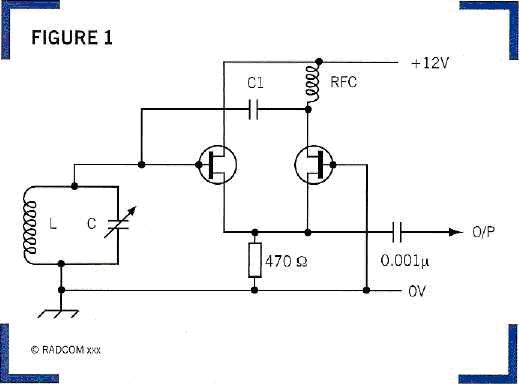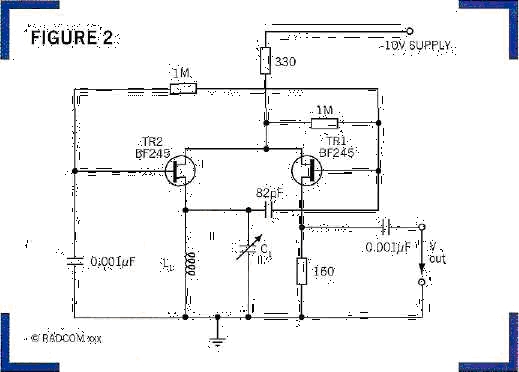NADESŁAŁ: SP6RGB
Artykuł pochodzi z czasopisma RadCom nr 3/2006. Ponieważ jest bardzo
duże zainteresowanie tym tematem postanowiłem wrzucić "surowy"
materiał, który otrzymałem od Roberta. Jest to skan oryginalnego
artykułu przepuszczonego przez program OCR :-)
WIDE-RANGE
TUNABLE OSCILLATOR WITH
STABLE OUTPUT. Over the years, 'TV has included a number of oscillator circuits featuring the use of
two active devices in
order to permit the use of two-terminal tuned circuits with one side-grounded. For example, as long ago as
TT' September
1970, the late LA8AK sent along details of a simple source-coupled FET oscillator that could
function with an appropriately-tuned
circuit from about 1 MHz
right up to VHF: Fig 1.

FIG 1: SOURCE-COUPLED FET LC-TUNED OSCILLATOR USING TWO MPF120, 2N3819 ETC, AS DESCRIBED BY THE LATE LA8AK IN 1970.
THE VALUE OF C1 SHOULD BE CHOSEN TO SUIT THE
FREQUENCY, BUT OFTEN OF THE ORDER
OF 10PF. FOR USE FROM ABOUT 1 MHZ TO VHF,
A
recent three-page item, JLC Oscillator Has Stable Amplitude', by Julius
Foit of the Czech Technical University, in the 'Design Ideas' column of EDN (October
17, 2005), begins:
"Many applications call for wide-range-tunable
LC oscillators that can deliver a nearly-constant frequency,
nearly-harmonic-free output,
even when the circuit's output load changes. From a
design viewpoint, eliminating both inductive or
capacitive LC circuit taps and transformer
couplings within the frequency-determining circuit simplifies
fabrication and production, as does the option of grounding one side of
the tuned LC circuit. These requirements suggest a circuit that can
automatically and efficiently adjust loop gain internally, the basic
requirement for oscillation. In addition, the circuit must provide
sufficient gain to oscillate with low-impedance LC circuits and
regulate the oscillation's amplitude to improve frequency stability and
minimise THD (total harmonic distortion)." Julius Foit discusses in
some detail the design processes leading him to come up with the
complete oscillator circuit shown in Fig 2.

FIG 2. WIDE-RANGE LC-TUNED OSCILLATOR WITH STABLE AMPLITUDE AS
DESCRIBED BY JULiUS FOIT IN EDN USES TWO N-CHANNEL BF245B JFETS. WITH
SUITABLE LC VALUES IT IS CLAIMED TO WORK WELL FROM ABOUT 5kHz TO 50MHZ
In his application as a radar-marker generator, the oscillator operates
at around 280kHz with an L of 147/UH and C of 2200pF. But it is claimed
that the circuit will provide stable amplitude oscillation as low as
5kHz and up to 50MHz with no adjustment of component values apart from
the L and C of the tuned circuit. Variations in load impedance will
affect frequency stability and for VFO applications it would be
advisable to use a buffer stage. At the higher frequencies, stability
will be influenced by mechanical and constructional factors, as for any
other oscillator. Foit claims that the best active devices for this
oscillator are the selected N-channel, medium-grade BF245B devices with
a drain current of 5mA at a gate-to-source voltage of 0V and a
drain-to-source voltage of 15V.
Prawa autorskie © SP-QRP Wszystkie prawa zastrzeżone.

